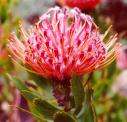Discover Tasmanian native carnivorous plants
Sundews and bladderworts:
 Photo: Utricularia dichotoma, also known as fairy aprons, growing near Zeehan on Tasmania's west coast. (Supplied: Darren Cullen)
Photo: Utricularia dichotoma, also known as fairy aprons, growing near Zeehan on Tasmania's west coast. (Supplied: Darren Cullen) While most people are familiar with leafy insect-eating plants such as the Venus flytrap or pitcher plant, many may not realise Tasmania is home to its own unique carnivorous plants.
Darren Cullen's collection of flesh-hungry flora ranges from the commonly found and produced carnivores to rare endemic plants.
"We get people travelling here to see Tasmanian carnivorous plants," he said.
"I pick them up from Hobart Airport, drive two minutes, pull over — it's that easy.
 Photo: Drosera arcturi, often called sundews, growing wild on Scotts Peak in Southwest National Park. (Supplied: Darren Cullen)
Photo: Drosera arcturi, often called sundews, growing wild on Scotts Peak in Southwest National Park. (Supplied: Darren Cullen)
"We have two genera of carnivorous plants here, Drosera and Utricularia, otherwise known as sundews and bladderworts.
"You grow bladderworts for their amazing flowers as the traps are underground."
Many varieties of carnivorous plants found in Tasmania can also be found in Victoria and New Zealand.
"We have plants here that are technically endangered [in Tasmania] but common on the mainland," Mr Cullen said.
Tips for growing carnivorous plants
- Most commercially available carnivorous plants are not tropical and should not be kept inside. Venus flytraps, sundews and pitcher plants all need to experience winter.
- Find a sunny position for your plant in the backyard.
- Most carnivorous plants live in swampy conditions and should always be kept wet, preferably sitting in a bowl of rainwater, but tap water is also fine.
- Do not force feed your carnivorous plants.
- If repotting your plant, check what soil type they require and pot accordingly.
- Depending on where you live, birds may be a problem — it can help to place stones in pots next to your plant so birds don't raid the pot for nesting material.
One of the best places to see endemic Tasmanian carnivorous plants is the Hartz Mountains in the state's south, where Drosera murfetti can be seen in the thousands.
There is strong demand among carnivorous plant collectors around the globe for Tasmanian varieties.
"It's not so much the plant itself but where it's from," Mr Cullen said.
"There may be a subtle variation which different regions produce; this is what makes them so desirable."
There are about 18 species of carnivorous plants in Tasmania, although Mr Cullen stressed this number was a matter of regular debate among experts.
"The 18 species are spread between the two genera, but the exact total is always debateable and in a state of flux as taxonomists argue and move plants around between species, subspecies, varieties and cultivars," he said.
 Photo: Drosera murfetti, a type of sundew, at Hartz Mountains in southern Tasmania. (Supplied: Darren Cullen)
Photo: Drosera murfetti, a type of sundew, at Hartz Mountains in southern Tasmania. (Supplied: Darren Cullen)
 Photo: Utricularia barkeri at Lake Pedder. Also known as a bladderwort, it's an unfortunate name for a pretty flower. (Supplied: Darren Cullen)
Photo: Utricularia barkeri at Lake Pedder. Also known as a bladderwort, it's an unfortunate name for a pretty flower. (Supplied: Darren Cullen)




Stunning little plants. Thanks Sandi.
Don't know how I missed your post before this. Maybe it was buried on the main page under the seemingly never-ending stream of scammer posts we get at times.